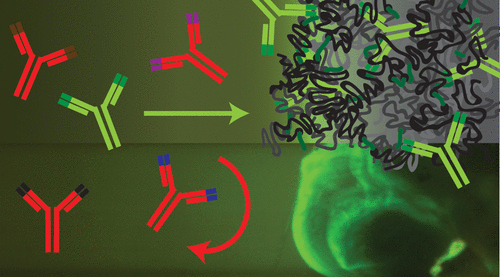当前位置:
X-MOL 学术
›
Biomacromolecules
›
论文详情
Our official English website, www.x-mol.net, welcomes your feedback! (Note: you will need to create a separate account there.)
Nucleopore-Inspired Polymer Hydrogels for Selective Biomolecular Transport
Biomacromolecules ( IF 6.2 ) Pub Date : 2018-09-05 00:00:00 , DOI: 10.1021/acs.biomac.8b00556 Yun Jung Yang 1 , Danielle J. Mai 1 , Thomas J. Dursch 1 , Bradley D. Olsen 1
Biomacromolecules ( IF 6.2 ) Pub Date : 2018-09-05 00:00:00 , DOI: 10.1021/acs.biomac.8b00556 Yun Jung Yang 1 , Danielle J. Mai 1 , Thomas J. Dursch 1 , Bradley D. Olsen 1
Affiliation

|
Biological systems routinely regulate biomolecular transport with remarkable specificity, low energy input, and simple mechanisms. Here, the biophysical mechanisms of nuclear transport inspire the development of gels for recognition and selective permeation (GRASP). GRASP presents a new paradigm for specific transport and selective permeability, in which binding interactions between a biomolecule and a hydrogel lead to faster penetration of the gel. A molecular transport theory identifies key principles for selective transport: entropic repulsion of noninteracting molecules and affinity-mediated diffusion of multireceptor biomolecules through a walking mechanism. The ability of interacting molecules to walk through hydrogels enables enhanced permeability in polymer networks. To realize this theoretical prediction in a novel material, GRASP is engineered from a poly(ethylene glycol) network (entropic barrier) containing antibody-binding oligopeptides (affinity domains). GRASP is synthesized using simultaneous bioconjugation and polycondensation reactions. The elastic modulus, characteristic pore size, biomolecular diffusivity, and selective permeability are measured in the resulting materials, which are applied to regulate the transport of equally sized molecules by preferentially transporting a monoclonal antibody from a polyclonal mixture. Overall, this work presents rationally designed, nucleopore-inspired hydrogels that are capable of controlling biomolecular transport.
中文翻译:

用于选择性生物分子转运的受核孔启发的聚合物水凝胶。
生物系统常规地以显着的特异性,低能量输入和简单的机制来调节生物分子的运输。在这里,核转运的生物物理机制激发了识别和选择性渗透(GRASP)凝胶的发展。GRASP提出了一种针对特定转运和选择性渗透性的新范例,其中生物分子与水凝胶之间的结合相互作用导致凝胶的更快渗透。分子运输理论确定了选择性运输的关键原理:非相互作用分子的熵排斥和通过步行机制的多受体生物分子的亲和力介导的扩散。相互作用的分子穿过水凝胶的能力使聚合物网络中的渗透性增强。为了用一种新颖的材料实现这一理论上的预测,GRASP是从包含抗体结合寡肽(亲和结构域)的聚乙二醇网络(熵屏障)中改造而成的。GRASP是使用同时的生物共轭和缩聚反应合成的。在所得材料中测量弹性模量,特征孔径,生物分子扩散性和选择性渗透性,将其用于通过优先从多克隆混合物中转运单克隆抗体来调节大小相等的分子的转运。总的来说,这项工作提出了能够控制生物分子运输的,设计合理,受核孔启发的水凝胶。GRASP是使用同时的生物共轭和缩聚反应合成的。在所得材料中测量弹性模量,特征孔径,生物分子扩散性和选择性渗透性,将其用于通过优先从多克隆混合物中转运单克隆抗体来调节等大小分子的转运。总的来说,这项工作提出了能够控制生物分子运输的,设计合理,受核孔启发的水凝胶。GRASP是使用同时的生物共轭和缩聚反应合成的。在所得材料中测量弹性模量,特征孔径,生物分子扩散性和选择性渗透性,将其用于通过优先从多克隆混合物中转运单克隆抗体来调节等大小分子的转运。总的来说,这项工作提出了能够控制生物分子运输的,设计合理,受核孔启发的水凝胶。
更新日期:2018-09-05
中文翻译:

用于选择性生物分子转运的受核孔启发的聚合物水凝胶。
生物系统常规地以显着的特异性,低能量输入和简单的机制来调节生物分子的运输。在这里,核转运的生物物理机制激发了识别和选择性渗透(GRASP)凝胶的发展。GRASP提出了一种针对特定转运和选择性渗透性的新范例,其中生物分子与水凝胶之间的结合相互作用导致凝胶的更快渗透。分子运输理论确定了选择性运输的关键原理:非相互作用分子的熵排斥和通过步行机制的多受体生物分子的亲和力介导的扩散。相互作用的分子穿过水凝胶的能力使聚合物网络中的渗透性增强。为了用一种新颖的材料实现这一理论上的预测,GRASP是从包含抗体结合寡肽(亲和结构域)的聚乙二醇网络(熵屏障)中改造而成的。GRASP是使用同时的生物共轭和缩聚反应合成的。在所得材料中测量弹性模量,特征孔径,生物分子扩散性和选择性渗透性,将其用于通过优先从多克隆混合物中转运单克隆抗体来调节大小相等的分子的转运。总的来说,这项工作提出了能够控制生物分子运输的,设计合理,受核孔启发的水凝胶。GRASP是使用同时的生物共轭和缩聚反应合成的。在所得材料中测量弹性模量,特征孔径,生物分子扩散性和选择性渗透性,将其用于通过优先从多克隆混合物中转运单克隆抗体来调节等大小分子的转运。总的来说,这项工作提出了能够控制生物分子运输的,设计合理,受核孔启发的水凝胶。GRASP是使用同时的生物共轭和缩聚反应合成的。在所得材料中测量弹性模量,特征孔径,生物分子扩散性和选择性渗透性,将其用于通过优先从多克隆混合物中转运单克隆抗体来调节等大小分子的转运。总的来说,这项工作提出了能够控制生物分子运输的,设计合理,受核孔启发的水凝胶。


























 京公网安备 11010802027423号
京公网安备 11010802027423号